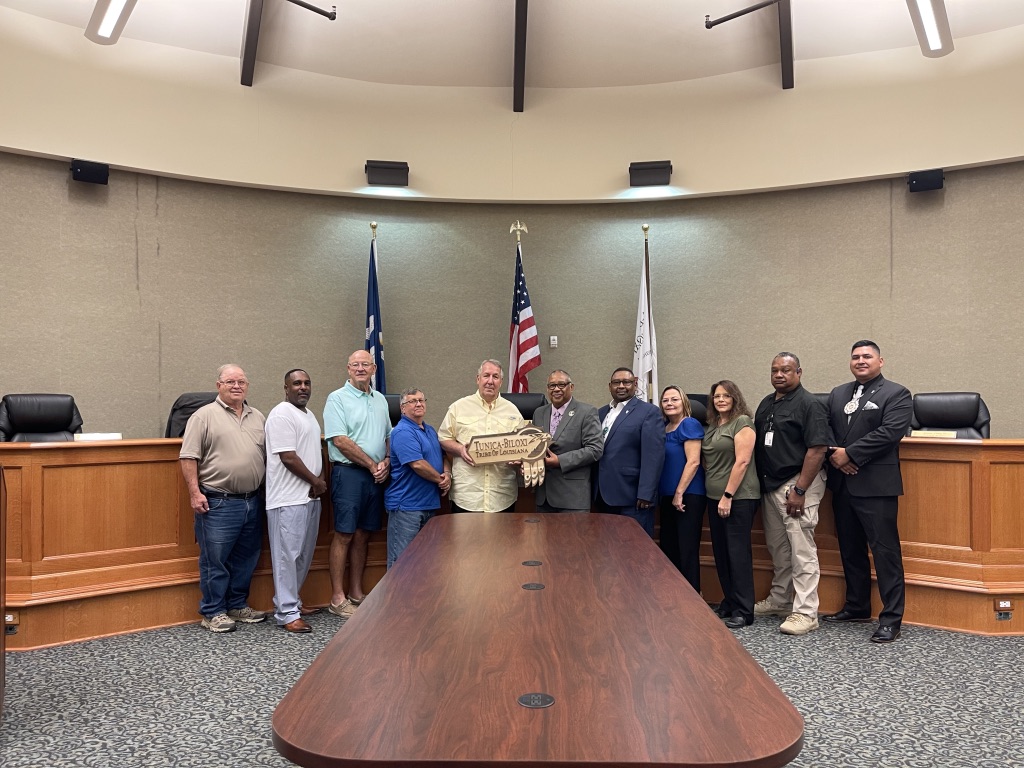
The Tunica-Biloxi Tribe of Louisiana reached an agreement with the City of Marksville to regain control of ancient burial grounds and surrounding lands.
For more high-res images, click here.
Marksville, La. – Sept 23, 2022 – The Tunica-Biloxi Tribe of Louisiana and the City of Marksville signed an agreement transferring ownership of the Marksville Historic State Park back to the Tunica-Biloxi Tribe. The park is the location of sacred Native American burial grounds containing ancestral remains from Tunica-Biloxi citizens that once inhabited the area. The Tribe plans to update and restore the property while also maintaining the grounds and educating the public on the cultural significance of the park.
“Regaining ownership of this land and expanding public access to Tunica-Biloxi citizens is integral to the continued mission of Tribal leadership,” said Earl Barbry, Jr., Tunica-Biloxi Director of Community Planning “This land has significant cultural value for our community, and we are pleased to continue preserving our rich culture and heritage on this site.”
The Tunica-Biloxi Tribe of Louisiana will restore The Historic State Park and generate continued awareness of the storied history of the Tunica-Biloxi Tribe. The site’s cultural significance is a driving force for the revitalization and beautification of this park. This project will also benefit the Tribe’s museum-focused tourism campaign and generate employment opportunities for tribal citizens and the surrounding community while bringing awareness to the Tribe’s history.
“This site is of significant value to the Tunica-Biloxi Tribe as part of our storied history here in Louisiana,” said Tunica-Biloxi Chairman Marshall Pierite. “Prior Tribal leadership worked for many years to restore this sacred place to the Tribe, and we are pleased to once again be caretakers of our native lands.”
“The City of Marksville has long been a partner with the Tunica-Biloxi Tribe of Louisiana,” said Marksville Mayor John H. Lemoine. “This alliance reflects just another chapter in the Tribe’s ancestral history here in Marksville and their work to support this community.”
The 42-acre Marksville State Historic Site is located on a bluff overlooking the Old River, adjacent to the town of Marksville. Archaeologists consider this prehistoric Native American ceremonial center to be of unique significance. The Marksville culture, a southeastern variant of the Hopewell culture centered in Ohio and Illinois, was characterized by elaborate mortuary ceremonialism, the construction of conical burial mounds, complex trade networks, decorative pottery and the importation of certain raw materials. It is also possible that this is the site of agriculture of a limited nature, such as the horticulture of native plants.
Although archaeological sites had been recognized throughout this area for many years, it was not until 1926 that the importance of the Marksville site was established. In that year, Gerald Fowke of the Smithsonian Institute conducted the first scientific investigation of the area and produced a detailed map of the Marksville site. In 1933, James A. Ford, an undergraduate student at Louisiana State University, and F. M. Setzler, also of the Smithsonian Institute, uncovered evidence that connected Marksville to the development of the Hopewell culture, which was then known to be based primarily in Ohio.
The Indian Mound, which is the main portion of the Marksville site, is surrounded by semi-circular earthwork which is 3,300 feet long and ranges from 3 to 7 feet in height. The open side of the enclosure is the edge of a bluff along the Old River. Openings in the earthwork, one on the western side and two on the southern end, suggest that its purpose was ceremonial rather than defensive. This enclosure probably was built to delineate a special area where the dead were buried, and formal affairs were conducted. Six mounds of various sizes and shapes are located within the main enclosure, and others are built outside of it. The Marksville State Historic Site was designated a National Historic Landmark by the U.S. Department of the Interior in 1964, and thus joined a select group of properties that have since been recognized for their importance in American history.
It is estimated that this land has not been in the possession of a Native American nation since the early 1800s. The late Earl Barbry Sr was the first tribal chairman to try to regain possession of this land. However, the only terms Chairman Barbry was able to obtain involved the city of Marksville leasing said land back to the Tunica-Biloxi nation. This did not satisfy the chairman’s desire. So, after decades and multiple generations of tribal chairmen and state governors, both sides finally came together to execute this transfer of land ownership.